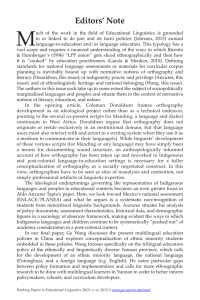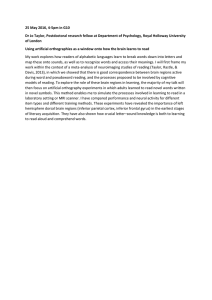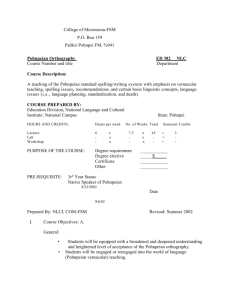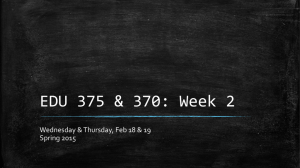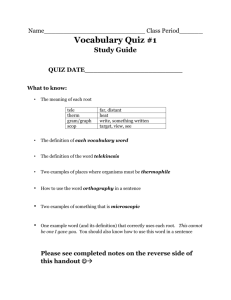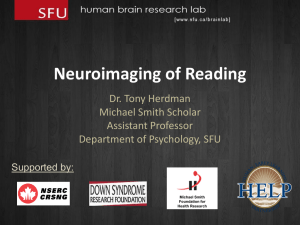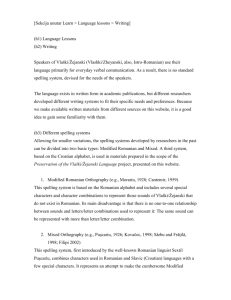The Social Life of Orthography Development Coleman Donaldson University of Pennsylvania
advertisement
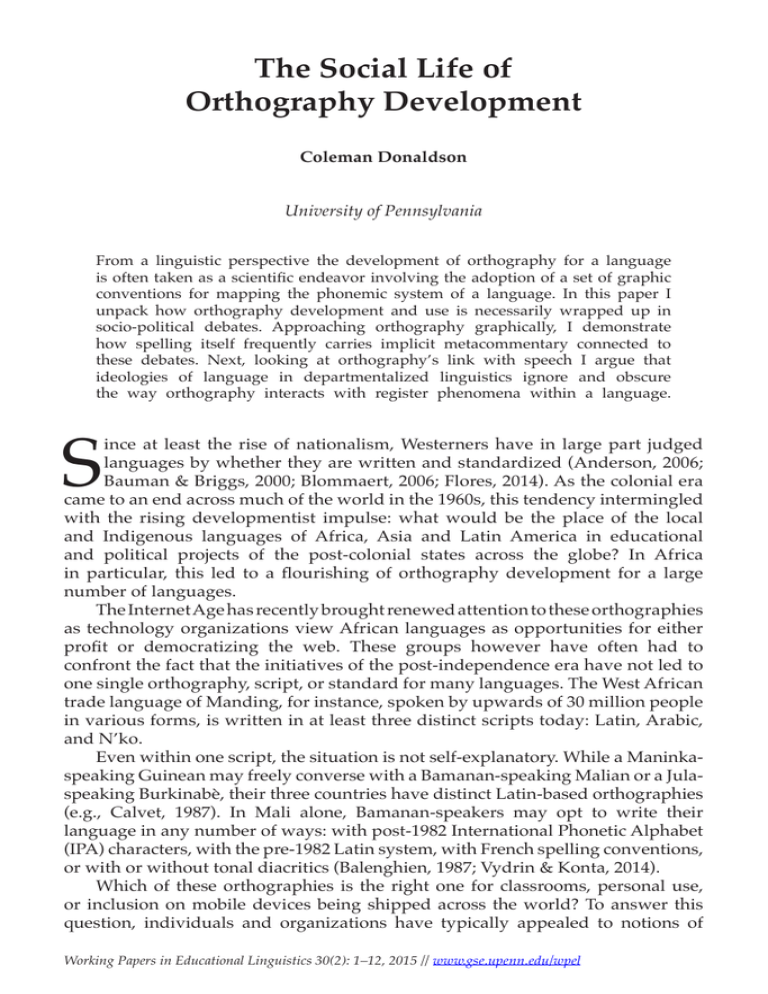
The Social Life of Orthography Development Coleman Donaldson University of Pennsylvania From a linguistic perspective the development of orthography for a language is often taken as a scientific endeavor involving the adoption of a set of graphic conventions for mapping the phonemic system of a language. In this paper I unpack how orthography development and use is necessarily wrapped up in socio-political debates. Approaching orthography graphically, I demonstrate how spelling itself frequently carries implicit metacommentary connected to these debates. Next, looking at orthography’s link with speech I argue that ideologies of language in departmentalized linguistics ignore and obscure the way orthography interacts with register phenomena within a language. S ince at least the rise of nationalism, Westerners have in large part judged languages by whether they are written and standardized (Anderson, 2006; Bauman & Briggs, 2000; Blommaert, 2006; Flores, 2014). As the colonial era came to an end across much of the world in the 1960s, this tendency intermingled with the rising developmentist impulse: what would be the place of the local and Indigenous languages of Africa, Asia and Latin America in educational and political projects of the post-colonial states across the globe? In Africa in particular, this led to a flourishing of orthography development for a large number of languages. The Internet Age has recently brought renewed attention to these orthographies as technology organizations view African languages as opportunities for either profit or democratizing the web. These groups however have often had to confront the fact that the initiatives of the post-independence era have not led to one single orthography, script, or standard for many languages. The West African trade language of Manding, for instance, spoken by upwards of 30 million people in various forms, is written in at least three distinct scripts today: Latin, Arabic, and N’ko. Even within one script, the situation is not self-explanatory. While a Maninkaspeaking Guinean may freely converse with a Bamanan-speaking Malian or a Julaspeaking Burkinabè, their three countries have distinct Latin-based orthographies (e.g., Calvet, 1987). In Mali alone, Bamanan-speakers may opt to write their language in any number of ways: with post-1982 International Phonetic Alphabet (IPA) characters, with the pre-1982 Latin system, with French spelling conventions, or with or without tonal diacritics (Balenghien, 1987; Vydrin & Konta, 2014). Which of these orthographies is the right one for classrooms, personal use, or inclusion on mobile devices being shipped across the world? To answer this question, individuals and organizations have typically appealed to notions of Working Papers in Educational Linguistics 30(2): 1–12, 2015 // www.gse.upenn.edu/wpel WPEL Volume 30, Number 2 what is standard in name or custom. While this approach may be appropriate in situations where a language has a strong and developed culture of literacy and publication, it is not of much help for what I have outlined above. In fact to do so blatantly ignores the ways in which one’s choices of script, orthography, or spelling can align oneself with competing socio-political projects. My goal in this paper therefore is to move beyond the typical linguistic approach that views orthography development as a scientific endeavor involving the adoption of graphic principles for mapping the phonemic system of a language. By drawing on linguistic anthropology and anthropological studies of postcolonial and Indigenous language education, I hope to provide a framework for taking into account not only the technical side of orthography but also its language ideological component. Orthography as Writing Scholars of education and linguistics have long argued that students learn best when they are taught in their first language (e.g., Cummins, 1979; Goldenberg, 2008; Thomas & Collier, 2002). This is unsurprising; many laypersons intuitively argue that individuals learn best when instruction is in a language that they understand and command. Across the post-colonial world, this theory about mother-tongue education has been integrated into a range of projects with goals as bureaucratic as improving educational outcomes or as radical as “decolonising the mind” (Thiongʼo, 1986). Both manifestations of the spectrum arose in West Africa in the decades following independence. In all cases though, literacy was central. Educational initiatives did not focus on simply using local languages as the oral medium of instruction but, more importantly, on promoting the ability to read and write in them. The written word has long been regarded as having unique properties allowing for spiritual, intellectual or cognitive benefits depending on the society. While not particularly Western (the clerical classes of Islam have long had similar understandings of literacy’s power [Chejne, 1969]), this idea became strongly linked to home-grown conceptualizations of Western superiority during the imperial and colonial periods (Mignolo, 1992). In Sub-Saharan Africa, where the literate tradition was limited for indigenous languages and not wide-spread in the case of Arabic, this gave rise to a conceptualization of Africans being on the wrong side of the great Oral-Literate divide of human societies (Goody, 1968). The lack of literacy was responsible for the continent’s subordinate place in the world— without it, Africans lacked the cognitive dispositions and advantages that would allow for them to successfully integrate into post-industrial society1. On this view literacy is autonomous (Street, 1984)—it is an isolatable and singular skillset that correlates with a range of desirable economic outcomes. Its promotion therefore was the solution of choice for a generation of development professionals across both West Africa (Dumont, 1973; Turrittin, 1989) and the wider post-colonial world. The basic premise of this understanding, however, is now largely rejected by scholars of literacy thanks to the writings of those working 1 Echoes of this can also be seen in Cummins’ (1979) work on bilingualism which requires the development of cognitive academic language proficiency (CALP) in one’s first language, presumably through literacy. 2 The Social Life of Orthography Development under the banner of New Literacy Studies (e.g., Gee, 1989, 2008; Street, 1984). In the foundational work of this school, Street (1984) opts to ethnographically probe the literate/illiterate distinction in Iran. Contrary to the premise undergirding the ideas of Goody (1968) as well as UNESCO’s functional literacy programs, he finds that being literate often has little to do with one’s ability to graphically decode symbols representing speech on a page. Indeed, by this measure, many of those deemed illiterate in the world are, in fact, literate. For Street, therefore, literacy must be approached ideologically and understood to manifest itself in various culturally-embedded forms without any natural or inherent consequence for the brain, intellect, or spirit. While this insight from New Literacy Studies has made the rounds amongst scholars of literacy and education, it has not been applied to an essential component of institutionalized attempts at promoting literacy or mother-tongue education: the development of an orthography, or the conventions for writing a particular language in a particular script. For linguists, the task is simply one of efficiently creating a set of conventions for mapping the sound system of a language (Pike, 1947). This conceptualization, however, is of little use if one’s goal is to develop an orthography that is to be used, not only in reference grammars, but also in efforts to promote literacy as part and parcel of efforts toward social change. As such, in this section I draw on anthropologically-informed accounts of orthography in specific locales (e.g., Evers, 2011; Jaffe, 1996; Schieffelin & Doucet, 1994) as well as the recent work of Sebba (2011) to develop a conceptual framework for fruitfully reasoning about orthography in Indigenous and post-colonial language-ineducation situations. The Phonemics Debate Just as literacy was once approached as an autonomous technology whose use could offer cognitive benefits, many have approached orthography in a similar manner (Sebba, 2011, p. 14). Frequently there has been an assumption that there is evolutionary progress in orthographies from pictographic to logographic to syllabic and finally alphabetic systems (p. 15). Alphabetic systems are to be phonemic; they are to assign one graphic character to each phoneme of a language which offers supposed benefits in cognitive processing because of a closer matching to the proposed psychological reality of the phoneme (Sapir, 1985; Sebba, 2011, p. 17). Psycholinguists and scholars of reading have dedicated years to studying this idea now known as the Orthographic Depth Hypothesis, which posits that the closer (i.e., shallower [Klima, 1972]) to phonemic representation an orthography is, the easier it is to read (Frost & Katz, 1992). While a large body of research has investigated this hypothesis (see Venezky [1977] for a historical review of the field), firm conclusions have been hard to come by because different readers seem to benefit from different kinds of orthographies: Phonemic or ‘shallow’ orthographies may have advantages for learners at an early stage, but they may also have disadvantages, as morphological changes required by the grammar may result in a lack of ‘fixed wordimages’ which help the full-fledged reader. (Sebba, 2011, p. 23) 3 WPEL Volume 30, Number 2 As such, Sebba finds that “the structuralist insistence on ‘perfect’ phonemic orthographies was at best unnecessary, at worst bad science in its claim to deliver ‘learnability’” (p. 22). This conclusion is echoed in Bird’s (1999a, 1999b) research on tone and orthography in Cameroon. While this work is focused primarily on the need to mark tone or not in African languages, Bird ultimately uncovers that orthographies with different depths afford distinct advantages in different kinds of sentences. These conclusions harken back to the insights about literacy as practice because it suggests that ideally, developing an orthography must take into account for whom and for what literacy practices it will be used. Deciding upon an orthography’s so-called learnability for a particular user however is not just about accurately gauging their reading level; it is also about what an orthography represents sociologically (Bird, 2001). In short, the question of a correct orthography cannot simply be reduced to a linguist’s or a technician’s task. But how exactly is orthography a social practice? It can be viewed as such in at least two ways. Normative Versus Normalized Orthography While we typically think of orthography as the so-called proper, correct, or standard way of writing speech down, it is critical to see that an orthography or set of norms for writing can exist even without explicit rules. Orthographies exist along “thresholds of normativity” (Agha, 2007, p. 126). In the case of so-called grassroots literacies (Blommaert, 2008), users typically do not respect a single system of conventions for penning language; they write in non-elite local languages using the resources at their disposal often with little regard for adhering to one standard of writing. In the case of Ajami (Diallo, 2012; Mumin, 2014), or the writing of West African languages in Arabic script (sometimes with slight adaptations), for instance, there are typically no official decrees or written documents for articulating a normative model for writing (e.g., Donaldson, 2013). Normative in this sense refers to a standard that is “linked to judgments of appropriateness, to values schemes of ‘good’ vs. ‘bad’ behavior, and so on” (Agha, 2007, p. 125). Nonetheless, given that Ajami is frequently used in correspondence, there exists a normalized model or de facto standard that writers in general respect albeit with some variation. All of this suggests that we need not conceive of orthography as exclusively the realm of top-down policy makers or institutions. Even when orthographies are standardized through normative models by linguists they have a social life of their own that can lead to revisions. Indeed, for Bernard (1996) orthographies are never established by linguists but by publishers (p. 145). However, it is important that we not take this idea too literally. It is not publishers per se that decide upon an orthography; it is the act of writing and disseminating texts that leads to an orthography being established. Each and every time we write, whether we respect or flaunt an orthographic norm, we orient ourselves to a model for writing a language (an orthography) and provide a reflexive comment on it (Lucy, 1993). This can be a transparent comment on a script as in the case of choosing N’ko over an official Latin-based orthography for writing something in Manding on a government form, as I witnessed during 2013 fieldwork. More implicitly however, spelling, or the act of using an orthography, provides its own metacommentary (Rymes, 2014) about the orthography in question. 4 The Social Life of Orthography Development Metacommentary in this sense is an implicit message about the orthography that is distinct from the actual propositional content of any sentence written in said orthography. Enough metacommentaries on an orthography through divergent usage can lead to a shift in the normalized or de facto model in use. Frequently when this happens normative models or prescriptive decrees are shifted in order to be more in line with the normalized standard in use. It is publishers as individual creators of texts, and not publishers as institutions, that establish orthographies. In this sense, an orthography is the accumulated sediment of actual instances of spelling that reflexively formulate a model existing along a threshold of normativity for writing a language. The Social Life of Graphemic Conventions But how are explicit or official attempts at formulating an orthography also social practices? At the most overt level, we see that one’s choice of script—Latin, Arabic, or N’ko in the case of Manding—involves a potential iconic alignment with other orthographic communities. Moreover, the use of a script can also be wrapped up in the purpose of promoting a particular literacy. Many post-colonial governments, for example, promote local language literacy with an eye towards transitioning citizens to literacy in an official language (Sebba, 2011, pp. 76–79). This was also the case in the Soviet Union between 1935 and 1940 when most minority languages regardless of their written traditions in other scripts were officially transitioned to Cyrillic-based orthographies similar to that of Russian (Calvet, 1987, pp. 221–225). Clearly the choice of script is the most overt way of aligning or dis-aligning one speech community to or from another. Nonetheless, even the graphic conventions within a single script are subject to fierce debate as evidenced by Schieffelin and Doucet’s (1994) analysis of Haitian orthographic debates. Indeed, in Haiti all of the competing orthographic systems use the Latin script, but each orthography is associated with specific ideological positions about the purpose of literacy, the status and vision of Haitian Creole, and ultimately Haiti as a nation-state. On one hand, there is the phonemicist orthography which is argued to be easier for monolingual speakers and is supported by the Ministry of Education, the Catholic Church, and international literacy promoters. On the other, there is the etymological system of mainly the intelligentsia, teachers, and the middle class, who all want want an orthography as close to French’s as possible in order to facilitate the later learning of French. And of course, there are those who lie somewhere in between in their preference. Schieffelin and Doucet argue that ultimately it is not a debate about graphically capturing the sounds of Haitian Creole. Instead, [i]t is about the conception of kreyòl [sic] itself as a language and as element of Haitian national identity, about how Haitians situate themselves through languages at the national and international levels, and about the notions of Haitianness, authenticity, and legitimacy. (p. 188) Even during British colonial rule in East Africa, the question of orthographic conventions loomed large despite their clear preference for the Latin script over the Arabic script that was then widely in use for penning Swahili (Peterson, 2006). 5 WPEL Volume 30, Number 2 In the 19th- and 20th-century colonial period the British and Germans officially proposed at least six different orthographies. They varied in their approaches: different sets of diacritics to distinguish phonemes, unique IPA-style characters, etymological spellings, or a basic Latin-alphabet with English-style graphic conventions and less distinction of phonemes. Ultimately, during British rule following World War I, the debate came to be between two orthographies. On one hand, there was a simpler version that eliminated etymological spellings, evidence of Arabic origins in loanwords, and those characters and diacritics not found on a typewriter; on the other, there was an IPA predecessor from the International Institute of African Languages and Cultures (IIALC) that was proposed for all African languages, including Swahili. Peterson analyzes these final competing orthographies as indicative of the differing visions of two kinds of colonial servants: supporters of the IIALC orthography who “sought to create a continent-wide empire of letters” across which colonial officers could speak like natives; and those of the less phonemic orthography who sought efficient written command through Swahili, in which they would “rarely need to speak directly to Africans” (pp. 196–197). In both of these cases we see overwhelmingly that even the seemingly trivial details of orthography—for instance, whether to use digraphs (i.e., twoletter combinations for a single phoneme)—is intimately tied to larger sociopolitical debates. Orthography as Speech So far, our analysis of orthography as a social practice has only touched upon the purely graphic aspects of written discourse. However, orthography is not just a set of conventions for using a script to write; more precisely, it is a set of conventions for using a script to write a specific language. From a phonemicist perspective, the development of an orthography simply entails creating a one-toone match between graphemes (i.e., letters) and phonemes (i.e., sounds). As we have seen, the belief that a pure phonemic alphabet is superior for learnability is questionable in light of the need to cater to different kinds of readers and literacy events (Sebba, 2011, p. 23). Moreover, this entire approach for developing an orthography rests on the assumption that mapping the phonology of a language is a straightforward matter. Sociolinguists have long highlighted the presence of intralanguage variation where a code is composed of various sub-codes that may be variously construed as either distinct styles or distinct dialects of one language (Gumperz, 1962). Frequently, these sub-codes may also include phonological variation. Hornberger (1995) recounts how attempts at developing an orthography for Quechua in Peru confronted this very fact. Historically, Quechua had only three vowels. Currently, however, there are a number of Peruvian varieties that now have a five-vowel phonemic inventory. By the phonemic principle one would opt for two different orthographies despite the fact that the speech community identifies these disparate phonological systems as all being the language known as Quechua. In this sense, languages are not reducible to hermetically-sealed phonological systems. Given the insight that a language is not a uniform code shared by users, sociolinguists have typically built their analyses around the speech community 6 The Social Life of Orthography Development as defined “by regular and frequent interaction by means of a shared body of verbal signs” (Gumperz, 1968/2009, p. 66). But languages are not definable by actual interaction within a community. This is clearly demonstrated by the case of English being spoken in both the United States and India, for instance. Regardless of the expansive reach of information communication technologies, the majority of Americans and Indians are not connected by regular and frequent interaction in any direct sense. Hornberger and King’s (1998) discussion of the proposed written register, Unified Quichua2, in Ecuador shows that orthography aims to be a tool that either matches or calls into being not necessarily a speech community but rather a language community (Silverstein, 1998). Language communities in this sense are the imagined communities of the things called languages. As noted above a language is never one denotational code. They are socio-historical formations which by their very nature are comprised by a range of registers (Agha, 2007). Registers are not simply different ways of saying the same thing, but rather are “cultural models of action” within a language that are identifiable by: linguistic features; enactable pragmatic values; and a set of users (Agha, 2007, p. 169). No speaker of a language speaks all of the registers of a language, just as no one speaks just one register of a language. In this light, a language cannot be reduced to a single isolatable phonolexical grammatical code that a linguist elicits from an informant. This has serious implications for orthography development. A purely phonemic orthography almost necessarily only correlates with one or a few registers of a language and thereby ignores the ways that languages and language communities can transcend the dialectologist’s boundaries. Just as speakers themselves do not use one register of a language, an ideal orthography for a language community takes into account the fractionally divergent grammatical codes that have a social life as one language under one or multiple glottonyms. Indeed, in the case of post-colonial indigenous languages, “transcriptive tendencies” that “seek to calque pronunciation” neglect “the fact that codification presupposes the development of alternative registers for the language, aside from or parallel to the oral system” (Cerrón-Palomino, 1991, as cited in Sebba, 2011, p. 112). This observation suggests that phonemicist ideologies explain in part the post-colonial tendency in Africa to insist on codifying local pronunciation at the expense of transnational unified orthographies (Calvet, 1987, p. 220). This is not to say that an orthographic standard that is closer to one’s so-called native variety in terms of phonology or morpho-syntax could not be more beneficial in some ways. It could in fact be ideal from a pedagogical point of view as years of scholarly research in bilingual and mother-tongue education has pointed out (e.g., Cummins, 1979, 1995, p. 199). But the fact is that literacy itself, regardless of the society, always involves a particular register (in Agha’s [2007] technical sense) or what Gee (1989) calls a capital-D Discourse. Literacy is never simply knowing how to decode writing; it is always “a mastery of or fluent control over a secondary Discourse involving print” (Gee, 1989, p. 9, emphasis in original). Discourses for Gee “are ways of being in the world; they are forms of life which integrate words, acts, values, beliefs, attitudes, and social identities as well as gestures, glances, body positions, and clothes” (pp. 6–7). In this sense, Gee’s idea of Discourse is 2 Quechua and Quichua are regional hispanicized spellings in Peru and Ecuador, respectively, for the language-dialect continuum linguists commonly refer to as Quechua. 7 WPEL Volume 30, Number 2 closely aligned with Agha’s (2007) concept of register that is linguistic but also more broadly semiotic and frequently tied to distinct social persona with presumed goals, values, etc. Terminology aside, what is important is that literacy involves mastering a secondary register no matter how similar it is to the dominant register into which one was socialized. If literacy requires the mastery of a particular register in addition to the ability to decipher a graphic code or orthography, then it follows that an orthography itself always involves a register that is but one fragment of a particular language. The Metapragmatics of Standardization The written register that is codified as standard through the development and use of an orthography is typically viewed as language itself in the case of dominant Western languages such as English or French. In these cases, one register of a language is perceived as the baseline from which all other registers are viewed as deviant (Agha, 2007, p. 146). But what happens in the case of languages with a less well established standard register? In the case of Indigenous languages of Latin America we see that efforts at standardization are frequently framed around discussions of so-called purity (e.g., Dorian, 1994). Judging whether a form of language is pure or not is a token of metapragmatic typification (Agha, 2007, pp. 150–154). It is metapragmatic simply in the sense that it is an instance of language being used to “refer to and predicate about language in use” (Wortham, 2001, p. 71). Metapragmatic typifications are instances of larger valorization schemes or metapragmatic stereotypes that exist about languages and their registers. Given that an orthography entails the use of or attempt to create a particular register of the language as the written standard, it is clear that standardization always involves metapragmatic debates. Hornberger and King (1998), for instance, note in the case of Ecuadorian Quichua that “puristic attitudes expressed by Unified Quichua speakers and advocates may serve to undermine the sentimental and aesthetic appreciation for ‘authentic Quichua’” (p. 404). And Dorian (1994) suggests that attitudes of “purism” frequently plague efforts to effectively revitalize or revive minoritized languages particularly in the case of “small” languages (p. 492). Both of these cases deal with the fact that when ways of speaking transparently source multiple grammatical systems identifiable as languages (e.g., Spanish and Quichua), they are regarded as socalled impure forms of one of the source languages—normally the one which provides its morpho-syntactic frame. In this sense, when Dorian argues for compromise she is really suggesting that educators and activists loosen up their metapragmatic valorization of so-called purity and better calibrate their activities to the normalized forms of a language already used in the community. That is, they should better attend to the de facto standard register of their language that includes elements of other languages. Putting one’s written standardization efforts in line with the most widely normalized register is an ideal way to attempt to piggy-back off of its distribution and at least partial valorization. That said, it is important to see that there is no simple formula or best-practice regarding the degree of linguistic purity that one should pursue. First, the de facto standard is only the default variety for certain 8 The Social Life of Orthography Development kinds of activities and for certain kinds of people. Moreover, normalized ways of speaking are not necessarily prestigious. Certainly, in large language communities one segment’s ways of speaking may indeed be more highly valued than the normalized register. Mortimer’s (2006) investigation of the debate between academic Guaraní and the colloquial jopará register suggests, for instance, that academic Guaraní is readily valorized and therefore accepted by the rural populations of Paraguay, but not by urbanites. Hill and Hill (1980) show the ways that purist attitudes were actually utilized in the case of promoting Nahuatl over Spanish. Cases like this demonstrate that there is not a coding relationship between the level of linguistic purity or monolingualism in a standard register and its acceptance by a population. It is not the level of so-called purity but rather the metapragmatic scheme of valorization that better contributes to a register’s use. That is, it is peoples’ attitudes about that register (which we can assess through metapragmatic discourse) that potentially turn people off from using or learning it. In addition, if users of that register regularly denigrate others’ ways of speaking, then said others may come to negatively value the promoted register itself. In this sense, we see that developing an orthography is always in some way linked to normative standardization around a particular register of a language. Any attempt at promoting orthography then is confronted with a choice. Either it must attend to issues of register distinction already present in the speech community or call into being a new scheme of valorization around an already in-use or new register. Conclusion Here I have attempted to outline some of the language ideological components of orthographic development and standardization. On one hand, we have seen how orthography, as a way of graphically representing speech through choices in script and conventions, is necessarily wrapped up in socio-political debates. As such the very act of using an orthography in an act of spelling can serve to provide a metacomment not just about the orthography itself but also about the aforementioned debates. Secondly, I have outlined how any language is composed of fractionally divergent registers. The promotion of an orthographic standard therefore must always confront the fact that it is promoting one register of a language over another. While opting for the de facto or normalized standard register of a language is, in general, sound advice, we have seen that this alone does not guarantee its acceptance because a register always has a unique social domain. A register of a language therefore is always subject to distinct valorization schemes that can be tracked via metapragmatic typification. Post-colonial and Indigenous language promotion efforts therefore must take into account the ideological nature of orthography and standardization and not believe that there is a single best strategy that can guarantee success in promoting a writing system. The tools of linguistic analysis can provide an array of potential options as relates to script and orthography, but as I have shown here, spurring the adoption and use of an orthography often ultimately has little to do with efficiency or learnability. Success therefore requires that activists, businesses, and governments interested in promoting local language literacy and education attend to local context and be willing to connect the dots between orthography and other sociological phenomena. 9 WPEL Volume 30, Number 2 Acknowledgments I would like to thank the editors, reviewers, and David Hanks for helping me to improve this paper. Additional thanks to all of those who over the years have been supportive of the intellectual (and literal) wanderings that gave rise to this work. Coleman Donaldson is a doctoral student in Educational Linguistics at the University of Pennsylvania. He is interested in historical and current efforts at promoting African languages such as Manding for education and literacy. References Agha, A. (2007). Language and social relations. New York, NY: Cambridge University Press. Anderson, B. R. O. (2006). Imagined communities: Reflections on the origin and spread of nationalism. London, England: Verso. Balenghien, E. (1987). A propos de l’alphabet du bambara au Mali [About the Bambara alphabet in Mali]. Mandenkan, 14-15, 13–26. Bauman, R., & Briggs, C. L. (2000). Language philosophy as language ideology. In P. V. Kroskrity (Ed.), Regimes of language: Ideologies, polities, and identities. School of American Research Press. Bernard, H. R. (1996). Language preservation and publishing. In N. H. Hornberger (Ed.), Indigenous literacies in the Americas: Language planning from the bottom up (pp. 139–156). Berlin, Germany: Mouton de Gruyter. Bird, S. (1999a). Strategies for representing tone in African writing systems. Written Language and Literacy, 2, 1–44. Bird, S. (1999b). When marking tone reduces fluency: An orthography experiment in Cameroon. Language and Speech, 42, 83–115. Bird, S. (2001). Orthography and identity in Cameroon. Written Language and Literacy, 4, 131–162. Blommaert, J. (2006). Language policy and national identity. In T. Ricento (Ed.), An introduction to language policy: Theory and method (pp. 238–254). Malden, MA: Blackwell. Blommaert, J. (2008). Grassroots literacy: Writing, identity and voice in Central Africa. London, England: Routledge. Calvet, L.-J. (1987). La guerre des langues: Et les politiques linguistiques [Language wars: And language policies]. Paris, France: Payot. Chejne, A. G. (1969). The Arabic language: Its role in history. Minneapolis: University of Minnesota Press. Cummins, J. (1979). Linguistic interdependence and the educational development of bilingual children. Review of Educational Research, 49(2), 222–251. Cummins, J. (1995). Bilingualism and special education: Issues in assessment and pedagogy. Austin, TX: Pro-Ed. Diallo, I. (2012). Qur’anic and Ajami literacies in pre-colonial West Africa. Current Issues in Language Planning, 13(2), 91–104. Donaldson, C. (2013). Jula Ajami in Burkina Faso: A grassroots literacy in the former Kong Empire. Working Papers in Educational Linguistics, 28(2), 19–36. Dorian, N. C. (1994). Purism vs. compromise in language revitalization and language revival. Language in Society, 23(4), 479–494. 10 The Social Life of Orthography Development Dumont, B. (1973). Functional literacy in Mali: Training for development. UNESCO. Evers, C. (2011). Orthographic policy and planning in Sénégal/Senegaal: The détournement of orthographic stereotypes. Working Papers in Educational Linguistics, 51(1), 21–51. Flores, N. (2014). Creating republican machines: Language governmentality in the United States. Linguistics and Education, 25, 1–11. Frost, R., & Katz, L. (1992). The reading process is different for different orthographies: The orthographic depth hypothesis. Orthography, Phonology, Morphology and Meaning, 94, 67. Gee, J. P. (1989). Literacy, discourse, and linguistics: Introduction. Journal of Education, 171(1), 5–17. Gee, J. P. (2008). Social linguistics and literacies: Ideology in discourses. London, England: Taylor & Francis Group. Goldenberg, C. (2008). Teaching English language learners: What the research does—and does not—say. American Educator. Goody, J. (1968). Literacy in traditional societies. Cambridge, England. Cambridge University Press. Gumperz, J. J. (1962). Types of linguistic communities. Anthropological Linguistics, 4, 28–40. Gumperz, J. J. (2009). The speech community. In A. Duranti (Ed.), Linguistic Anthropology: A Reader (2nd ed.) (pp. 66–73). (Original work published 1968) Hill, J. H., & Hill, K. C. (1980). Mixed grammar, purist grammar, and language attitudes in modern Nahuatl. Language in Society, 9(3), 321–348. Hornberger, N. H. (1995). Five vowels or three? Linguistics and politics in Quechua language planning in Peru. In J. W. Tollefson (Ed.), Power and inequality in language education (pp. 187–205). New York, NY: Cambridge University Press. Hornberger, N. H., & King, K. (1998). Authenticity and unification in Quechua language planning. Language, Culture and Curriculum, 11(3), 390–410. Jaffe, A. (1996). The second annual corsican spelling contest: Orthography and ideology. American Ethnologist, 23(4), 816–835. Klima, E. S. (1972). How alphabets might reflect language. In J. F. Kavanagh & I. G. Mattingly (Eds.), Language by ear and by eye: The relationship between speech and reading (pp. 57–80). Oxford, England: Massachusetts Institute of Technology Press. Lucy, J. A. (1993). Reflexive language and the human disciplines. In J. A. Lucy (Ed.), Reflexive language: Reported speech and metapragmatics (pp. 9–32). Cambridge, England: Cambridge University Press. Mignolo, W. (1992). The darker side of the Renaissance: Literacy, territoriality, and colonization. Ann Arbor: University of Michigan Press. Mortimer, K. (2006). Guaraní académico or Jopará? Educator perspectives and ideological debate in Paraguayan bilingual education. Working Papers in Educational Linguistics, 21(2), 45–71. Mumin, M. (2014). The Arabic script in Africa: Understudied literacy. In M. Mumin & K. Versteegh (Eds.), The Arabic script in Africa: Studies in the use of a writing system (pp. 41–78). Leiden, Netherlands: Brill. 11 WPEL Volume 30, Number 2 Peterson, D. (2006). Language work and colonial politics in eastern Africa: The taking of standard Swahili and “School Kikuyu.” In D. L. Hoyt & K. Oslund (Eds.), The study of language and the politics of community in global context (pp. 185–214). Plymouth, England: Lexington Books. Pike, K. L. (1947). Phonemics: A technique for reducing languages to writing. Ann Arbor: University of Michigan Press. Rymes, B. (2014). Marking communicative repertoire through metacommentary. In A. Blackledge & A. Creese (Eds.), Heteroglossia as practice and pedagogy (pp. 301–316). New York, NY: Springer. Sapir, E. (1985). The psychological reality of phonemes. In Selected writings of Edward Sapir in language, culture and personality (46–60). Oakland: University of California Press. Schieffelin, B. B., & Doucet, R. C. (1994). The “real” Haitian Creole: Ideology, metalinguistics, and orthographic choice. American Ethnologist, 21(1), 176–200. Sebba, M. (2011). Spelling and society: The culture and politics of orthography around the world. Cambridge, England: Cambridge University Press. Silverstein, M. (1998). Contemporary transformations of local linguistic communities. Annual Review of Anthropology, 27(1), 401–426. Street, B. V. (1984). Literacy in theory and practice. Cambridge, England: Cambridge University Press. Thiongʼo, N. wa. (1986). Decolonising the mind: The politics of language in African literature. London, England: J. Currey; Heinemann. Thomas, W. P., & Collier, V. P. (2002). A national study of school effectiveness for language minority students’ long-term academic achievement. Santa Cruz, CA: Center for Reearch on Education, Diversity and Excellence. Turrittin, J. (1989). Integrated literacy in Mali. Comparative Education Review, 33(1), 59–76. Venezky, R. L. (1977). Research on reading processes: A historical perspective. American Psychologist, 32(5), 339. Vydrin, V., & Konta, M. (2014). Propositions pour l’orthographe du bamanankan [Propositions for Bamanankan orthography]. Mandenkan, 52, 22–54. Wortham, S. (2001). Narratives in action: A strategy for research and analysis. New York, NY: Teachers College Press. 12
